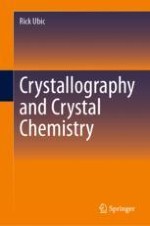2024 | OriginalPaper | Buchkapitel
15. Ionic Bonding
verfasst von : Rick Ubic
Erschienen in: Crystallography and Crystal Chemistry
Aktivieren Sie unsere intelligente Suche, um passende Fachinhalte oder Patente zu finden.
Wählen Sie Textabschnitte aus um mit Künstlicher Intelligenz passenden Patente zu finden. powered by
Markieren Sie Textabschnitte, um KI-gestützt weitere passende Inhalte zu finden. powered by
